Physical Address
304 North Cardinal St.
Dorchester Center, MA 02124
Transoral robotic surgery (TORS) has significantly improved the intraoperative and postoperative management of difficult-to-reach head and neck neoplasms. Prior to the development of TORS, open surgical approaches greatly impacted postoperative functional outcome and quality of life. These open procedures, when used to eradicate lesions of the oropharynx, hypopharynx, skull base and nasopharynx, involved long operative times, prolonged hospital stay and increased morbidity compared to TORS [ ].
In contrast to other minimally invasive surgical alternatives, such as endoscopic and microscopic techniques, robotic technology is utilitarian. Benefits associated with the da Vinci® Surgical System include 3D optics with high magnification and resolution, the assistance of more than one set of hands in the field, the ability to operate outside the direct line-of-sight, and a wide variety of operative instruments [ , ]. Its unique EndoWrist® technology affords specific advantages, including natural wrist freedom associated with 7 degrees of motion, absence of fulcrum effect, enhanced precision and tremor filtration [ ]. TORS may allow the operator to avoid external incisions, and it minimizes disruption of normal tissue planes compared to more invasive approaches [ , ]. Robotic systems can also be excellent teaching tools [ ]. Surgeons can mentor by sharing their view, providing two-dimensional telestration via freehand sketching over images, and proctoring via a dual console [ ]. The safety profile of this robotic application has been well validated in pre-clinical studies, animal subjects and human models [ , , , ]. TORS was approved by the Food and Drug Administration (FDA) in 2009 for otolaryngologic surgical resection of benign lesions, as well as malignant T1 and T2 head and neck tumors in adults [ ].
The major aim of TORS is to provide local disease control while optimizing functional outcome, quality of life and cosmesis. This includes decreasing the rate of postoperative tracheostomy and gastrostomy dependence [ ]. Another major goal is to provide a valid minimally invasive alternative to non-surgical therapies in order to minimize drug toxicity and associated morbidity, particularly in young patients [ , ]. When adjuvant treatment is necessary, dose reduction may be a reasonable goal in certain patients: e.g., with favorable pathologic risk stratification or a relatively small postoperative target tissue volume [ ].
In the early 2000s, robotic systems were used in ENT procedures in porcine and cadaveric models [ ]. McLeod et al. reported the first operation on a living patient, with excision of a benign vallecular cyst [ ]. Although McLeod et al. introduced the robotic arms via the mouth, the procedure was not a success because the authors used a laryngoscope and only two arms (the camera and one other instrument) to unroof a cyst. TORS, which for the first time utilized three robotic arms via mouth retractors, was developed at the University of Pennsylvania in 2004 [ ]. The team published results from the first human translational research subjects, who underwent robotic tongue base resection of T1 and T2 squamous cell carcinoma, in 2006 [ ]. The FK retractor was identified as the most versatile retractor for intraoral exposure, but the Crow Davis and Dingman retractors are valid alternatives. Orotracheal or nasotracheal intubation is performed, based on surgeon preference [ ]. Initially, 8 mm instruments were utilized, and the development of 5 mm instruments enhanced the versatility of the da Vinci® Surgical System. Typically, the surgeon operates at the console while an assistant is available at the head of the bed. If possible, the tumor is resected en bloc.
Current indications for TORS are primarily based on the absence of metastatic disease and favorable anatomic characteristics in patient and tumor in terms of accessibility, visibility and thus the probability of achieving negative margins. In 2009, the FDA cleared the da Vinci® system for T1 and T2 oral, pharyngeal and laryngeal cancers and benign tumors. It is not currently FDA cleared for T3 and T4 lesions [ ]. However, TORS has been employed for appropriate candidates with advanced stage disease including up to T4a oropharyngeal lesions [ , ]. In the oropharynx, TORS is contraindicated if neck disease is not resectable, if there is evidence of mandibular invasion or carotid artery or prevertebral fascia involvement, or if the tumor involves more than 50% of the tongue base or posterior pharyngeal wall [ ]. In the larynx, surgical limitations also include accessibility and size [ ]. Resectability of laryngeal lesions, in particular, must be balanced with functionality compared to non-surgical alternatives [ ]. Approaches and indications for skull base tumor resection are being developed in a stand-alone fashion, as well as in combination with endoscopic techniques [ ].
In 2010, the role of TORS was expanded by Vicini et al. to include base of tongue resection for the treatment of OSA [ ]. TORS for OSA has since progressed to include resection at multiple levels, including lingual tonsillectomy, uvulopalatopharyngoplasty (UPPP), supraglottoplasty, Z-palatoplasty (ZPP), uvulopalatal flap, limited pharyngectomy, and epiglottectomy or epiglottoplasty [ ]. TORS provides easy exposure of the hypopharynx, and this consistent ease of exposure facilitates surgery for OSA. TORS posterior glossectomy and limited lateral pharyngectomy with UPPP have been shown to significantly decrease apnea duration and reduce apnea-hypopnea index (AHI) by more than 50% [ ]. Midline glossectomy and ZPP were more effective than other minimally invasive alternatives (radiofrequency treatment or submucosal coblation) in reducing AHI [ ]. As multilevel surgical approaches to manage airway obstruction in sleep apnea continue to evolve, TORS promises marked improvement in treatment outcome compared to continuous positive airway pressure (CPAP), the current gold-standard therapy, for a subset of suitable patients [ ].
Exciting technological advances are on the horizon for TORS, many of which revolve around improvement in visualizing and accessing the operative site. The da Vinci® SP™ Surgical System introduces the possibility of a single port approach, as well as flexible endoscopes [ ]. Its initial FDA clearance is currently for urologic procedures, but it may ultimately present a new landscape for the evolution of TORS. Moore et al. described another innovative method to improve visualization in TORS, using currently available technology and placing the patient in a seated position, thereby improving line-of-sight access to the inferior pharynx and larynx [ ].
The future of TORS will lead to new devices and operative frontiers. Teletransmission of surgical movement through a robotic system may enable surgical expertise to be available in remote locations and improve surgical training worldwide [ ]. Though shown to be feasible, telesurgery is not widely implemented, due to practical and legal restrictions. Nevertheless, collaboration and innovation will continue to enable TORS to impact future patient care. Its limits will be defined only by the imagination of its patrons.
* Bernier J (Ed). Head and Neck Cancer. Multimodality Management. Springer ; 2016. p. 388–390. Reproduced with permission of Springer.
The development of partial laryngeal surgery in the 1970s [ ] and endoscopic laser surgery in the 1990s [ ] aimed to reduce functional and esthetic sequelae while maintaining oncological efficacy. The development of transoral robotic surgery (TORS), which emerged in 2005 [ ], was also initiated in an attempt to achieve this goal. B. O'Malley and G. Weinstein's team in Philadelphia (Pennsylvania, USA) used the da Vinci® robot to treat a benign oropharyngeal tumor after a feasibility study was conducted on a porcine model [ ]. Studies assessing TORS for the treatment of upper aerodigestive tract cancer were published as early as 2008 [ ]. Current indications for robotic surgical procedures include T1-T2 tumors of the oropharynx and the supraglottic larynx.
However, this type of endoscopic surgery involves difficulties associated with the robot-related materials (robot arms and instrumentation), patient apprehension, tumor exposure and the individual surgeon's learning curve. The aim of this text is to update the current status of robotic surgery for the treatment of cancers of the upper aerodigestive tract.
All TORS procedures are performed under general anesthesia and oral or nasotracheal intubation. The da Vinci® robot has several components: the robot itself, a surgeon's console, light sources, 3D camera and mono- and bipolar generators. It is recommended to use one of the three specific mouth gags available (FK Olympus®, LARS retractor Fentex® and M Micro France®). These provide large access to the pharynx in order to place the 8 mm optic at an angle of 0° or 30° inside the pharynx, using the two robotic arms equipped with instruments (Maryland forceps and monopolar electrocautery) ( Figure 7.1 ). The arms are controlled by the surgeon, who works near the patient from a console with 3D vision and up to 10-fold magnification. Installation time (approximately 20 to 30 minutes) for the retractor and arms is essential. Good exposure of the tumor is the key to a successful TORS procedure. An assistant is always positioned at the patient's head to aspirate fluids and fumes and monitor the position of the arms inside the mouth so as to prevent potential conflict. An operating room nurse loads and cleans the instruments on the robot arm. At the console, the surgeon manipulates two joysticks that transmit motion to instruments with a ratio of 5 to 1. This enables high-precision movements and eliminates tremor. Using the joysticks is very natural, allowing the operator to work in a comfortable sitting position. It is necessary to reposition the retractor and robot arms during tumor resection. Resection uses the monopolar forceps, and hemostasis uses the Maryland forceps. The wound is left to control healing or sutured with a local flap, depending on its location.
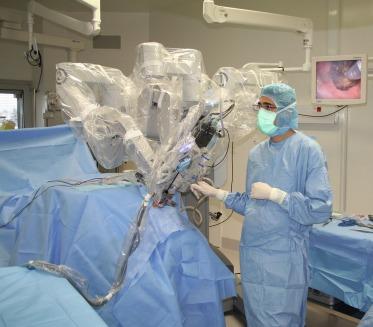
As stated by Weinstein et al. [ ], preoperative endoscopy can be used to select patients eligible for robotic surgery. The surgeon who will perform the robotic surgery using the dedicated retractor must also perform the endoscopy. The main criteria assessed on preoperative endoscopy are the anatomical location and size of the tumor, mouth opening and maxillo-mandibular anatomy. Small mouth opening and/or large tongue base are contraindications that only the surgeon can evaluate. With this pre-selection, a very small number of patients prove ineligible due to poor exposure. Only 13 out of 129 patients had inadequate exposure in a multicenter study by Weinstein et al. [ ].
The Food and Drug Administration (FDA) approved TORS only in T1-T2 tumors of the oropharynx, larynx and hypopharynx. The absence of tactile force feedback makes palpation impossible with the robotic instruments, which makes highly invasive tumors ineligible, in our experience. The size of the robotic instruments (8 mm) is too large for working in the endolarynx, where endoscopic laser surgery is preferred. Selection of patients eligible for TORS must be approved by the multidisciplinary team meeting (oncologist, radiologist, histologist and head and neck surgeon) on the basis of the results of the endoscopic evaluation, cervical and thoracic CT scan and histologic diagnosis.
Start-up in robotic surgery cannot be improvised and must be planned so that the whole team is properly informed before initiating the first case. Health institutions that invest in an expensive robotic system should routinely offer this training. Ideally, the first case should be scheduled within 2 weeks of training. In addition, the first case should be easy (small tumor of the tonsil) and supervised by an experienced TORS surgeon. Under these conditions, the learning curve is quite fast. Several publications [ , ] have shown that TORS duration for a given surgeon decreased significantly after the first 10 patients. The surgical team must follow a progression in the programming of cases, beginning with lesions of the oropharynx, followed by the supraglottic larynx, and finally the hypopharynx.
The anesthesia required for TORS is not different from that required for other endoscopic surgeries. We prefer nasal intubation, to avoid placing the probe in the oral cavity. Weinstein et al. performed oral intubation, placing the probe in the contralateral labial commissure [ ].
The quality of resection margins is an important prognostic factor in local control. The use of frozen section is highly recommended when there are short margins.
In a TORS series from a group of surgeons in France [ ], neck dissection was performed in the same step in most cases but, for larger tumors with risk of cervical fistula, it can be postponed for 2 weeks. Where there is significant risk of intraoperative bleeding (risk of injury to the lingual artery), neck dissection can be performed first, to control and bind the branches of the external carotid that risk being injured.
The large number of publications on TORS confirms the growing role of this new technology for the surgical treatment of head and neck cancer. Team training, assessment of tumor exposure and adherence to oncological rules are essential criteria for this less invasive surgery. The contribution of technical innovations is expected to partially compensate for the absence of tactile force feedback. The use of reconstruction surgery by local or free flaps is also under development. Finally, the future of robotic surgery in our discipline lies in the development of new systems dedicated to TORS, with articulated thinner arms and flexible endoscopes. Several projects are underway and are expected to become available in the coming years.
Advantages of TORS
A 3D endoscope at 0° or 30° provides large access to the pharyngeal cavity.
TORS enables high-precision movements and eliminates tremor.
TORS for T1 and T2 pharyngeal tumors has the same oncological results as conventional open surgery.
Limitations of TORS
TORS needs team training and assessment.
Preoperative endoscopy must be performed by the TORS surgeon to select patients eligible for robotic surgery.
The use of a dedicated mouth gag is recommended.
The absence of tactile force feedback makes palpation impossible with the robotic instruments; highly invasive tumors are therefore ineligible.
Robot-assisted head and neck surgery has developed over the past 10 years, with constant adaptation not only of the specific instrumentation (the robot itself) but also of the non-specific instrumentation used in associated procedures, whether scheduled or emergency.
There are currently two robotic surgery systems available on the international market. The older, which has been available for a decade, is the da Vinci® robot in its successive versions. The more recent model, available since 2014, is the Flex® robotic system, designed exclusively for use via the orifice.
Transoral procedures require an operative assistant at the patient's head ( Figure 7.2 ) to ensure suction of smoke and blood and take hold of the resection specimen with instruments adapted to the presence of the robotic instruments in the operative field.
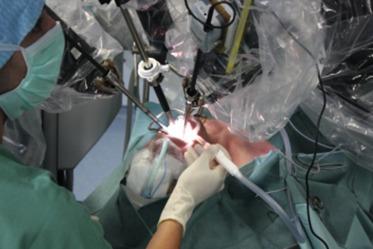
We will consider successively the instruments used for introducing the robotic arms (retractors), suspension instruments, and those for additional procedures such as lymph node dissection, surgical reconstruction or for emergency cases (hemostasis, airway release).
According to the situation and surgeon's preferences, minimalist or invasive retractors may be used. Retractors have been well described by O'Malley et al. [ ]. They range from the Boyle Davis ( Figure 7.3 ), Dingman or FK retractor to specific retractors that are being constantly improved, such as S. Morinière's Retractor ( Figure 7.4 ) or the newly designed retractor for the Flex® robotic system.
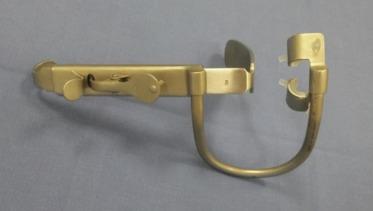
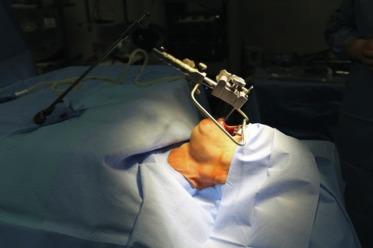
Suspension systems have progressed from the single shelf to specific systems (Flex)®. Stabilizers used in digestive surgery (e.g. Omnitract Integra®) ( Figure 7.5 ) can also provide complete stabilization for transoral or transcutaneous retractors.
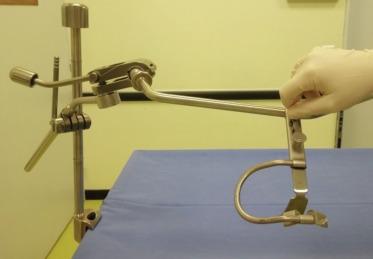
Transoral or transcutaneous surgery is performed in a confined space where smoke and mist on the endoscope can hinder the surgeon's movement. Continuous suction is therefore necessary, but must not interfere with the procedure (instruments, sight). Suction can be directly included in the retractor ( Figure 7.6 ) or use a long flexible suction cannula ( Figure 7.7 ).
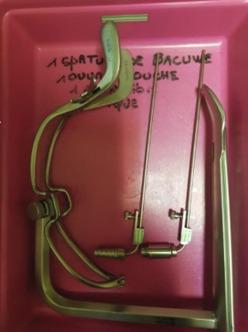
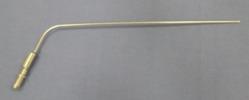
Lymph node dissection is often associated to transoral tumor surgery and requires basic head and neck surgery instruments, and hemostasis instruments such as a mono- or bipolar electrocautery or hemoclip. It is also recommended to have instruments for emergency tracheostomy or cervical vascular surgery in the operating room in case of uncontrolled transoral bleeding.
It is necessary to have a good arm support to put the patient's arm in abduction [ ]. Gynecologic or autostatic retractors can be used to help the manipulation of the robot instruments.
An operating table synchronized with the robot needs to be developed for head and neck robotic surgery, as used in abdominal robotic surgery. Currently, the operating table should allow secure rotation and roll to position the robot's base and arms according to the patient's morphology.
Robotic equipment needs an operating room providing adequate space for the robot. The operating room is used by several surgeons, with discussion before beginning robotic surgery. Various requirements have to be discussed (area, floor, connectors, etc.).
There is no specific anesthesia equipment, but transoral robotic surgery requires the anesthesia team to be at the patient's foot because of the space taken up by the robot.
The incidence of upper aerodigestive tract tumor, taking all locations together, seems to be slightly decreasing overall, but that of oropharyngeal tumor in particular seems rather to be slightly on the increase. This is in line with the particular epidemiological pattern of reduced alcohol consumption and smoking but an increase in HPV-related carcinoma [ ].
Historically, oropharyngeal cancer was systematically treated by often heavy surgical resection (cervico-mandibulotomy), particularly before the 1940s. Radiation therapy and then chemoradiotherapy gradually emerged as effective options, in direct competition with surgical indications. Indications for chemoradiotherapy, developed in the 2000s, gradually extended as oncology assessment demonstrated results equivalent to those of surgery, with reduced morbidity.
In a review of the literature in 2002, Parsons et al. reported that oncologic results in operable oropharyngeal tumor were equivalent between surgery and concomitant chemoradiotherapy [ ].. Thus, between the 1990s and 2010, non-surgical treatment of oropharyngeal tumor has increased as rates of surgical resection decreased ( Figure 7.8 ) [ ].
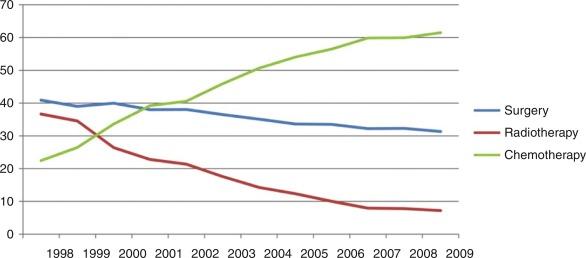
American results were corroborated by the most recent update of the 94-01 GORTEC study [ ] in Europe, confirming the advantage of non-operative treatment associating concomitant platinum-based chemotherapy and radiation therapy.
It was basically because of the morbidity associated with surgery that non-operative management became more widespread for the treatment of locally operable oropharyngeal tumor since the 1990s. The rate of early complications in classic open surgery (i.e. oropharyngectomy via mandibulotomy) before the advent of TORS was estimated at nearly 25%, compared to less than 10% with concomitant chemoradiotherapy. Indications for oropharyngectomy have progressively shifted from first-line attitude to salvage [ ].
The oncologic benefit of associating chemotherapy to radiation therapy in oropharyngeal cancer is now established, especially in locally advanced forms [ ]. Nevertheless, the side-effects of non-operative treatment are well known: rates of grade 3 or 4 mucositis rise from <40% to > 70% when chemotherapy is associated concomitantly to radiation therapy [ ], requiring gastrostomy and support care for more than 25% of patients [ ].
TORS has progressively developed as first-line treatment for oropharyngeal tumor since it received FDA clearance in 2009. Like with laser surgery some years earlier, the interest lay in limiting surgical morbidity. All the reports published since the first TORS procedures indicate the feasibility of therapeutic de-escalation, although there have as yet been no randomized studies comparing TORS versus concomitant chemoradiotherapy.
Since 2009, TORS indications have significantly increased, by 7.9% and 11.3% respectively, for AJCC (American Joint Committee on Cancer) grades I and II tumor [ ] while indications in grades III and IV have remained stable ( Figure 7.9 ). The same pattern holds comparing stage T1/T2 versus T3/T4.

The current trend is thus a return to resection, but by TORS, when this approach is feasible and resection can be deemed functional. TORS is especially favored for lesions otherwise inaccessible to surgery without mandibulotomy (T2 electively). In this situation, the morbidity of open surgery contrasts with non-operative concomitant chemoradiotherapy.
The main indication for TORS is resection of oropharyngeal tumor. In the 2012 multicenter study of TORS by Weinstein et al., 78% of the tumors were oropharyngeal, and 95% malignant [ ]. The French Group of Transoral Robotic Surgery [ ] reported 169 patients treated between 2009 and 2014; tumor stages were T1 in 51 cases, T2 in 100, T3 in 16 and T4 in 2; 6.7% of patients could not be managed by TORS, due to exposure problems. The authors all consider that these can be anticipated on preoperative endoscopy performed by an operator with experience in TORS, for prior assessment of the feasibility of positioning a retractor, reducing the rate of such intraoperative problems to less than 1% [ ].
In Kelly et al.'s literature review [ ] of 11 relevant publications, all studies used systematic frozen section biopsy. Five of the 173 oropharyngeal specimens (2.9%) were intralesional on definitive histology (T1/T2 tumors); the patients underwent surgical revision, achieving final negative margins.
Kelly et al., in their literature review [ ], examined the treatment of lymph-node areas in T1/T2 oropharyngeal tumor managed by TORS. Most authors recommended lymph-node treatment in the same step as TORS, while a minority deferred it to limit the risk of mucosal breach [ ]. There no longer seems to be a good argument for dissociating TORS and neck dissection; indeed, one advantage of the one-step attitude is the possibility of access to the lingual vascular pedicles for intraoperative ligation if necessary [ ].
In seeking to reduce morbidity, it has been natural to reduce the rate of intraoperative tracheotomy during TORS. In the 2012 North American study based on results from the MD Anderson Cancer Center, the Mayo Clinic and the Universities of Pennsylvania and Alabama, incidence of intraoperative tracheotomy was low, but highly variable from team to team [ ], ranging from 5% to nearly 30% for planned tracheotomy; rates of definitive tracheotomy, on the other hand, were consistently less than 2%. Yeh et al., in a review of the literature comparing TORS versus intensity-modulated radiation therapy (IMRT) (in non-randomized studies), found no significant difference in long-term tracheotomy according to treatment, with rates ranging between 0 and 4.5% in both [ ].
Iseli [ ] reported 68% of patients with exclusively oral feeding at discharge and 86% by day 14, with significantly higher rates in treatment of second primaries or recurrence. In Yeh et al.'s literature review [ ], prolonged enteral feeding rates ranged between 0 and 20.7%. These rates are just slightly poorer than those for non-operative treatment associating IMRT and chemotherapy. Comparison is hindered by the lack of randomized studies. According to Kelly, the rate of dependence on enteral tube feeding, even partial, beyond 1 year was less than 5% [ ].
Although there is no consensus specific to TORS, most authors indicate adjuvant radiation therapy on classic criteria founded on postoperative pathology examination of the resection specimen (perineural invasion, vascular emboli, margin quality) and neck dissection findings (presence and number of invaded adenopathies, capsule rupture). In Weinstein et al.'s 2012 series of T1/T2 oropharyngeal tumor treated by robotic surgery and neck dissection without adjuvant radiation therapy, only 3% of patients showed locoregional recurrence [ ]; more than 80% of these were squamous cell carcinoma patients with negative margins (in some cases following revision surgery). In Smith et al.'s series[ ] in which 90% of the tumors were stage T1-T2, 21% of patients received postoperative adjuvant radiation therapy and 31% concomitant chemoradiotherapy; adjuvant treatment did not significantly improve survival. Iseli [ ] reported that 41% of patients managed by TORS received postoperative adjuvant radiation therapy.
In Iseli's series [ ], 22% of patients undergoing TORS had had prior radiation therapy; Aubry et al. [ ] reported a rate of 31%, without evidence of increased postoperative risk.
Yeh et al.'s literature review [ ] compared results in oropharyngeal cancer treated by surgery versus isolated IMRT in more than 40 studies; these were neither randomized nor controlled and tumor size tended to be smaller in the TORS groups; nevertheless, the data pointed to equivalence in oncologic results ( Table 7.1 ) and slightly better functional results with TORS.
| Author | N | Included stages | Median follow-up (years) | Overall survival (%) |
|---|---|---|---|---|
| IMRT | ||||
| Broglie et al. | 124 | T1-T4 | 3 | 69 |
| Chao et al. | 26 | Any T, any N | 2 | 100 |
| Daly et al. | 107 | Any T, any N | 3 | 83 |
| Eisbruch et al. | 67 | T1-T2, N0-N1 | 2 | 96 |
| Garden et al. | 776 | Any T, any N | 5 | 84 |
| Huang et al. | 71 | Stage 3/4 | 3 | 83 |
| Ingle et al. | 24 | Stage 3/4 | 2 | 92 |
| Nichols et al. | 44 | Stage 3/4 | 3 | 79 |
| May et al. | 170 | Any T, any N | 3 * | 87 |
| Mendenhall et al. | 130 | Any T, any N | 5 | 76 |
| Saba et al. | 65 | Stage 3/4 | 3 | 83 |
| Setton et al. | 442 | Any T, any N | 3 | 85 |
| Shoushtari et al. | 112 | Any T, any N | 3 | 77 |
| Yao et al. | 66 | Any T, any N | 3 | 78 |
In Kelly et al.'s meta-analysis [ ] of more than 200 articles comparing TORS versus concomitant radiation + chemotherapy in T1/T2 oropharyngeal tumor, there was no significant difference in survival according to treatment. Local control rates approximated 90% in both cases ( Figure 7.10 ). In Smith's series, 3-year overall survival was 94% [ ].
![Figure 7.10, Meta-analysis by Kelly et al. [ 11 ], showing no significant difference in survival between TORS versus concomitant radiation + chemotherapy. Figure 7.10, Meta-analysis by Kelly et al. [ 11 ], showing no significant difference in survival between TORS versus concomitant radiation + chemotherapy.](https://storage.googleapis.com/dl.dentistrykey.com/clinical/TransoralroboticsurgerywiththedaVincisystem/9_3s20B9782294760129000070.jpg)
Taken together, these studies tend to show oncologic equivalence between TORS and non-operative treatment. Functional comparison is greatly hindered by the lack of randomized studies. TORS, however, may, for an equivalent quality of results, avoid irradiating selected patients without indications for adjuvant radiation therapy, especially in small tumors that can be resected completely, without lymph-node invasion or histologic factors for poor prognosis.
In Weinstein et al.'s 2012 North American multicenter study, 95% of patients recovered full oral feeding [ ]. Iseli's figures [ ] were slightly lower, at just over 80%. Definitive swallowing disorder, assessed on functional scores, affected a minority of TORS patients; poor scores correlated with tumor size, treatment context at recurrence, and preoperative swallowing disorder. Differences between series related to analysis methodology and whether food was strictly normal or adapted.
Complications associated with TORS have been the focus of publications by several teams reporting their experience. During the first years, there were many small series, and this early information was very variable. It appeared that intraoperative complications were few, but that rates during the first month could be as high as 40% [ , , , ].
Become a Clinical Tree membership for Full access and enjoy Unlimited articles
If you are a member. Log in here